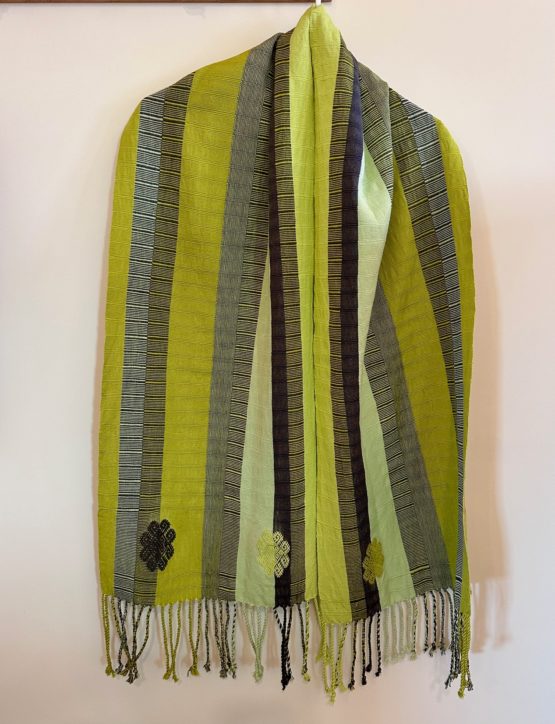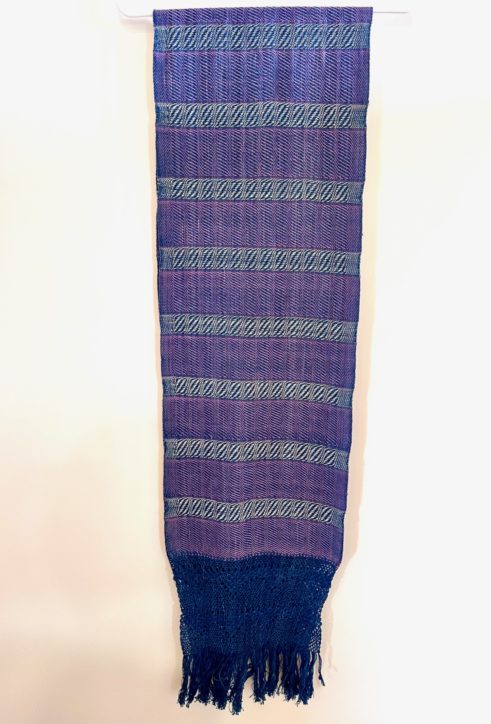Christmas in Oaxaca is magical. In ancient villages throughout the central valleys, indigenous Zapotec people celebrate with a mix of pre-Hispanic mystical ritual blended with Spanish-European Catholic practice.

A moment’s rest. Christmas Posada, Teotitlan del Valle, Oaxaca, 2015
They retrace the Census pilgrimage (Roman command to travel from Nazareth to Bethlehem for Cesar’s census) of Mary and Joseph on their way to Bethlehem. The posadas in Teotitlan del Valle are held for nine nights, culminating with the last posada on Christmas Eve. Each host family serves as innkeeper for the night, throwing a big party, and welcoming guests into the home.

Cradling Baby Jesus at the altar, Teotitlan del Valle
The procession is elaborate and takes the pilgrims and the litter carrying Mary and Joseph from one inn to the next, through the winding cobblestone streets of the village, touching each neighborhood. Women carrying beeswax candles and children with sparklers guide the way. Altar boys illuminate the streets with candle-topped stanchions.

The last posada, Christmas Eve, Teotitlan del Valle, Oaxaca
Copal incense leaves an aroma trail. Church officials send firecrackers skyward to announce the coming of the pilgrims to the next neighborhood. It is solemn, festive and spiritual.

Wishing you season’s greeting with health and joy always.
What could be better than to experience one day of this celebration with those who lives here? This is an informal cultural immersion walking tour, so be prepared to walk, and then walk some more! Please bring your camera if you like. You will have permission to take photos.
- When: Friday, December 22 — One Day ONLY
- Time: 1 p.m. to 9 p.m. (approximate end time)
- Where: Teotitlan del Valle, Oaxaca, Mexico
- Cost: $125 per person includes late afternoon supper
Who is this one-day study tour for? Anyone interested in knowing more about how Christmas is celebrated in a Mexican village. All amateur photographers are welcome, from no to mid-level experience, and anyone interested in photo tourism and who wants a more personal travel experience.
Group Size Limited to 8 People: We welcome children and young adults ages 12 and over.

Parking lot, Tlacolula market sky, Sunday before Christmas
You will follow me into the homes of Zapotec families to talk about and observe the celebrations and decorations. You will have plenty of photo opportunities to capture images of people and place. You will take home memories that cannot be duplicated, to be treasured and shared for a lifetime.

Nochebuena flower or poinsettia, native to Mexico, Christmas full-bloom
What You Will See:
- Behind the gates, behind the walls, honest village life
- Food preparation for special occasions
- Homes and altar rooms elaborately decorated for Christmas
- Candlelit processions, complete with incense and mysticism
During the day, we will visit several family homes to see how they celebrate Christmas. We will bring chocolate and bread to the altar in greeting, a tradition.

Blessings before the altar at the home of the Patron.
After dark, we will take part in the procession that will carry Mary and Joseph on litters from one home to the next on their recreated journey to Bethlehem.
Photography Opportunities–What You Will Do:
- Attend to natural and artificial lighting to get the best shot
- Practice street photography on-the-hoof
- Request permission from people to take their photos
- Discuss photo-taking etiquette, When to ask or not?
- Create portrait opportunities with the people you meet
- Gain access to family compounds
- Point out great photo opportunities
- Explore night photography challenges and opportunities
- Go home with a portfolio of your experiences

The pilgrims entering the altar room, Teotitlan del Valle
We DO NOT give instruction on how to use your camera. This will not be about camera settings or technical information. You will want to know your camera before you arrive. We will not offer an editing session or instructions on how to edit.

Food preparation area for posada participants
We DO provide a rich, cultural immersion experience, with all types of cameras welcome: mobile phone cameras, film, DSLR and mirrorless, instant, Poloroid, etc.
What to Bring:
- Your spirit of discovery and adventure
- Your camera
- Extra batteries and charger
- Extra storage disks
- Optional tripod, if you wish
- Notepad and pen
Lodging Options: You may wish to make this a day trip and return to Oaxaca city on the same night. Or you may wish to spend the night in Teotitlan del Valle (or perhaps several). Choose Casa Elena, Las Granadas B&B guesthouse, or La Cupula. Make your own reservations and pay your hosts directly.

Watching the procession go by, Teotitlan del Valle
About Your Photo Walking Tour Leader: Norma Schafer is an experienced amateur photographer who enjoys taking portraits as much as capturing the pulsating world of Oaxaca village life. Her photographs have been exhibited at Duke University, The Levine Museum of the American South, and featured in two chapters of the award-winning book, Textile Fiestas of Mexico (Thrums). She is most interested in the aesthetic of photography, rather than the technical details, acknowledging that to get a good photo, one must know how the camera works first!

The musicians always lead the way, announcing the coming of the procession
How to Book Your Reservation: Send Norma an email to let her know you want to participate. We will send you an invoice to make a PayPal payment to secure your place.
Cancellations: If, once you make your 100% prepaid reservation, and you find you are unable to attend, you may cancel up to 30 days in advance and receive a 50% refund. After that, refunds are not possible. You are always welcome to send a substitute in your place.

Even a blurry photo evokes mood and sense of place
Trip Insurance: We strongly encourage you to take out trip cancellation and medical evacuation insurance. We cannot emphasize enough how important this is when traveling in any foreign country. Since this is a one-day excursion, trip insurance is not mandatory, but highly advisable.
Like this:
Like Loading...


























































Feliz Fiestas and Happy Holidays from Oaxaca, Mexico
It’s a warm, sunny day here in Teotitlan del Valle, Oaxaca, Mexico. Temps are in the mid-70’s Fahrenheit and there’s a breeze. It will get down to 52 degrees tonight. A perfect day to welcome Baby Jesus to the world here in the southern part of North America.
Resting on a satin pillow is Baby Jesus, taken from his church altar to the Last Posada
There’s a band playing at the December 23-24 posada house and I can hear it across the village. At unpredictable moments, a firecracker will go skyward to boom in a blast that sounds like one shot has been fired. Tonight is La Ultima Posada, the last posada for 2017.
Procession of villagers with candles, a church official with copal incense burner
This morning I went to the market early, at 8:30 a.m. Ojala! It was a miracle, since I usually never get out of the house much before 10:00 a.m. Parking was scarce and I could hear a band on the street between the market and the church. It called to me. I hurried. Whenever a band plays here, you know there is something going on.
The band behind the moving altar plays energetic Sousa-style music
Baby Jesus had just been taken from his resting place in the church, an antique carved and gilded wooden figure. He was on a pillow held by a young woman who walked under a portable tent held upright by four stanchions and strong men to hold the posts.
The procession formed to pass through the major streets of Teotitlan del Valle on the way to place Baby Jesus in his birthplace at La Ultima Posada.
Delegation playing solemn music out front, led by wood carved Zapotec flute
The street was perfumed by copal incense, giving off smoke and a sweet aroma of burning sap, so essential to ancient Zapotec ceremonial tradition.
As the procession descended down Avenida Constitucion from the Zocalo along a steep cobblestone incline, I said to myself that I wish I had worn sturdier shoes. Nevertheless, I was able to keep up to get these photos to share with you.
Important family members of the posada host process with candles
Then, I went back uphill to the market to do my holiday food shopping. Tonight, I’m invited to the home of Hugo and Malena. I’m holding weekly English conversation meetings with their teenage son and daughter. They asked me to join them for Christmas Eve dinner, which usually doesn’t start here until around midnight. Not sure I can stay up that late. It’s pretty quiet around here on Christmas Day.
Back up the hill to the market and church zocalo
Enjoy this time of peace, reflection, calm and tranquility. The winter solstice brings us darkness, where we want to hover close with family and friends, take stock of our year and think about longer, warmer days ahead. I think of this as a metaphor for all the possibilities that life can bring us.
Blessings to all.
Norma Schafer, Teotitlan del Valle, Oaxaca, Mexico, December 24, 2017
From the village market, a view of the church steeples
Women buy field flowers for their aroma, akin to the past
I take home a bundle of sunflowers in the spirit of joy
Like this:
10 Comments
Posted in Cultural Commentary, Teotitlan del Valle, Travel & Tourism
Tagged Mexico, Oaxaca, posada, Teotitlan del Valle